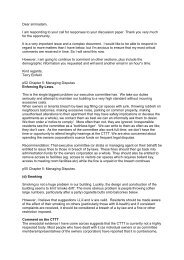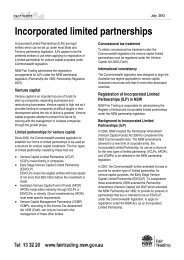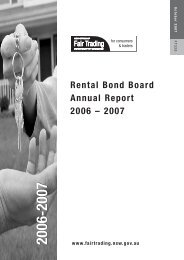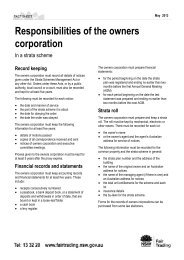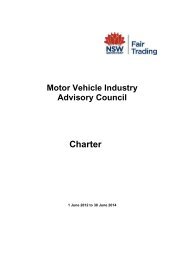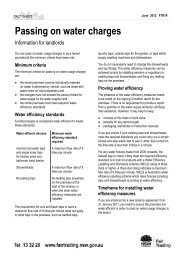High front guttering advisory committee report - NSW Fair Trading ...
High front guttering advisory committee report - NSW Fair Trading ...
High front guttering advisory committee report - NSW Fair Trading ...
You also want an ePaper? Increase the reach of your titles
YUMPU automatically turns print PDFs into web optimized ePapers that Google loves.
collective point of the manufacturers was that with such a dominance of high <strong>front</strong>ed <strong>guttering</strong> in<br />
the market place, one would expect a much higher presence of complaints if it was a “systemic<br />
problem”.<br />
In terms of explaining the finer points of high <strong>front</strong>ed gutter operation, most of the manufacturers<br />
drew attention to a number of informal overflow mechanisms which potentially worked to their<br />
advantage in appropriately managing overflow i.e. in high rainfall intensity events <strong>guttering</strong> can<br />
bend forward under the load of a full gutter of water and create a gap between the fascia and back<br />
of the <strong>guttering</strong> allowing water to overflow through the gap between the fascia and the back of the<br />
gutter. With some high <strong>front</strong>ed gutter designs (depending on how high the <strong>front</strong> of the gutter is) the<br />
bending forward also allows water to flow over the high <strong>front</strong>. One manufacturer tabled a <strong>report</strong><br />
from a university research centre that validated these phenomena (discussed in more detail under<br />
Section 10).<br />
In addition to the above, each manufacturer provided technical gutter data and it was apparent from<br />
this that some manufacturer’s products differed in design from others in things like cross sectional<br />
gutter area, the size of slots and the specific system for attaching the gutter to the fascia. Different<br />
brackets were also commonly used in replacement work compared to new work. In such cases, the<br />
gutter was often attached below the top of the existing timber fascia, thus reducing the likelihood of<br />
overflow into the building and thus differentiating such situations from concerns about metal fascia<br />
fixing methods. From these points, it was apparent that certain systems and installation situations<br />
had potential to perform better than others with regard to overflow management and in such<br />
instances it seemed difficult to lump the performance of all high <strong>front</strong>ed <strong>guttering</strong> in the same<br />
category.<br />
The Master Plumbers Association advised that they believed problems still existed concerning high<br />
<strong>front</strong>ed <strong>guttering</strong>, but provided no quantitative or significant evidence of the extent of failure. They<br />
advised that the only appropriate measure for dealing with overflow from high <strong>front</strong>ed <strong>guttering</strong> and<br />
preventing water ingress into buildings was the inclusion of a specific type of continuous overflow<br />
measure - they provided a diagram of a flashing feeding into back of the gutter, to be used in<br />
conjunction with an anti-ponding board (similar to the one shown in AS3500.3/3500.5). With regard<br />
to this, the Committee does not support a single solution because this is contrary to the<br />
performance based approach of the BCA.<br />
Anecdotal Reports of Overflow Problems<br />
Some submissions referred the Committee to newspaper <strong>report</strong>s of individual cases of overflow<br />
problems with high <strong>front</strong>ed <strong>guttering</strong>. While the Committee found such information useful in<br />
understanding the context of individual cases and to some extent the historical background<br />
concerning high <strong>front</strong>ed <strong>guttering</strong>, the Committee does not consider isolated coverage of individual<br />
cases in the press to represent a sufficiently substantial database of evidence of a “systemic<br />
problem” with high <strong>front</strong>ed <strong>guttering</strong>. It is also noteworthy that some articles appear to be based on<br />
“here say”, loose speculation or a limited number of cases and yet try to create a momentum about<br />
the scale of the problem, based on an apparent absence of strong objective evidence. The<br />
Committee’s attention was also drawn to State Emergency Services publications advising the<br />
community of the need to maintain <strong>guttering</strong> to prevent overflow during heavy rain periods as an<br />
indication of a “systemic problem”. Such publications provide general information to members of<br />
19



